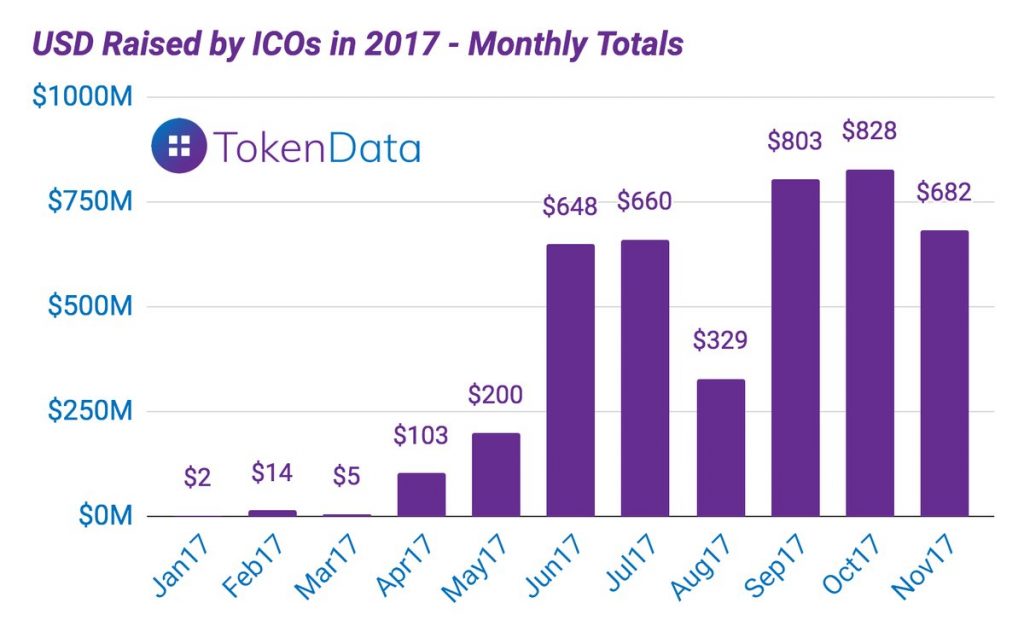
Once celebrities began endorsing ICOs, many were quick to claim that this was the top; the mania had reached its peak and the token bubble was about to pop. And when the SEC filed charges against several dubious projects, forcing others to return funds to investors, this assessment appeared to be accurate. Despite the mid-summer mania having dissipated, however, the number of ICOs in the works is higher than ever.
Also read: The Most Pointless Cryptocurrency Tokens Ever Invented
Reports of the ICO’s Demise Have Been Greatly Exaggerated
In the first nine months of the year, over $3 billion was raised in ICOs, almost $600 million of which came from Tezos, Filecoin, and Bancor. Despite most of the high-profile ICOs occurring in Q1 and Q2, October was actually the most lucrative month to date, pulling in $828 million. November, in comparison, could only muster $682 million.
It feels like 2017 was chockablock with ICOs, but the mania didn’t truly kick in until April. Tokendata reports that just $21 million was raised via ICOs in the first three months of the year before hitting $103 million in April and then almost doubling in May. In the year to date, over $4 billion has been raised, and there is a likelihood that the symbolic $5 billion threshold will be passed by 2018.

The Stats Don’t Lie
The success of each token project has little to do with hitting its hard cap; focusing on the money misses the bigger picture. From an investment perspective, the relative returns of each project, both in dollar and cryptocurrency terms, is naturally of interest though. Some of this year’s biggest ICOs, such as Filecoin, have yet to issue their tokens, while many more are still in the early development stage. As a result, it will be well into 2018 before this year’s reported success stories can be properly assessed.
While the revenue raised from ICOs dropped sharply in November, the number of crowdsales completed actually rose. Be it due to increased competition or weariness for all things “blockchain”, startups are having to settle for a smaller share of the spoils. One report states that in June, only one ICO failed to reach at least 75% of its fundraising target. But over the course of the next three months, 59% of ICOs fell short of that target.

Having delivered an average return of 13.2x this year, ICOs remain attractive to investors and startups alike. ICO Alert lists hundreds of token sales that are imminent or underway, and there is no sign of respite in the first quarter of next year. Analysts seem confident that ICO fever has some way to run yet.
Alexey Scherbin, Global CEO of crowdfunding consultancy ICO Producer, told news.Bitcoin.com:
The number of ICOs is growing faster than investment can flow into crypto assets, making it harder for investors to identify good projects. Due to the sheer number of ICOs, it’s harder for the projects that have real merit to attract investment without spending a lot of money on marketing.
He added: “We expect many of the problems affecting the ICO market to ease in 2018. Regulation in major countries may reduce the overall number of ICOs but will increase their quality, and they will remain an extremely popular way of attracting investment.”
This sentiment was echoed by Overstock CEO Patrick Byrne, who told CNN: “I’m actually quite supportive of the SEC cracking down. The ICO craze this year has led to a lot of people being fleeced. There’s been a lot of people bringing coins public with no business plan.”
Only this week, it emerged that Centra is facing a class action lawsuit, standing accused of violating securities law in its ICO.
Only Bitcoin Can Skewer the ICO Bubble
 The greatest threat to ICOs comes not from the SEC or a “decentralized” weary public, arguably, but from within. Evidence suggests that November’s sharp drop-off in crowdsale revenue is due to bitcoin’s breakout. The cryptocurrency has been in bullish form all year, but since November has gone parabolic, leaving altcoins and everything else in its wake.
The greatest threat to ICOs comes not from the SEC or a “decentralized” weary public, arguably, but from within. Evidence suggests that November’s sharp drop-off in crowdsale revenue is due to bitcoin’s breakout. The cryptocurrency has been in bullish form all year, but since November has gone parabolic, leaving altcoins and everything else in its wake.
Having seen funds tied up for months in Tezos’ ongoing legal dispute, investors seem cautious of committing to token sales when there are possibly better returns to be made simply by hodling bitcoin. Once the tearaway cryptocurrency stabilizes, ICO investments are likely to rise.

Despite bitcoin’s astonishing rally in Q4, token sales have still proven lucrative. Hybrid blockchain platform Dragonchain, for example, concluded its ICO in early November, raising $13 million and issuing DRGN tokens at around 6 cents each. The value of those tokens has since increased 25x, dwarfing even bitcoin’s impressive end-of-year run, despite having yet to be listed on a major exchange. With companies as diverse as Overstock, Breadwallet, and Openbazaar all launching their own token sales, it seems there’s plenty of life yet in the ICO.

For entrepreneurs desperate to get on the ICO bandwagon but struggling to come up with that one killer idea, help is now at hand. Yet Another ICO is a website that generates suggestions for decentralized projects. Under the tagline “Let’s make tokens useless again”, it conjures such ideas as the “First distributed influencer marketing platform for virtual reality”. As Poe’s law holds, there’s a fine line between sincerity and parody, and many of its proposals don’t sound so outlandish.
Despite being mocked, memed, and regulated hard, ICO fever remains high. Expect more of the same in 2018.
Do you think we’ve hit peak ICO or will crowd sales continue to break records in 2018? Let us know in the comments section below.
Images courtesy of Shutterstock, Coinmarketcap and Tokendata.
Bitcoin Games is a provably fair gaming site with 99% or better expected returns. Try it out here.
